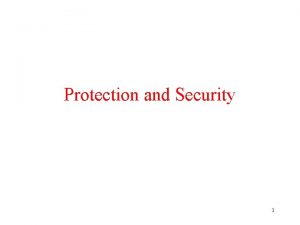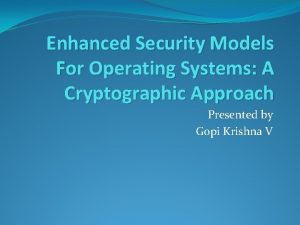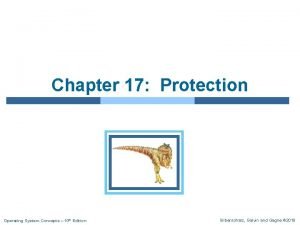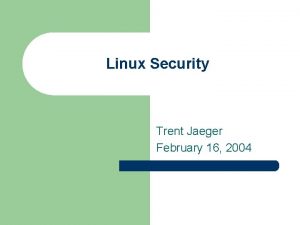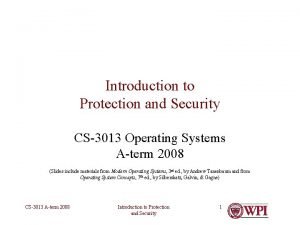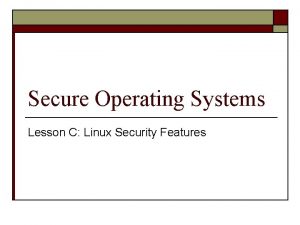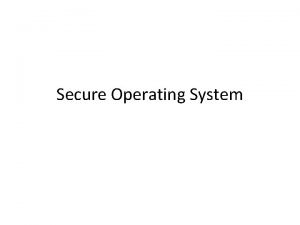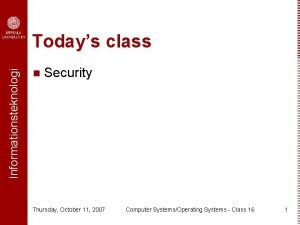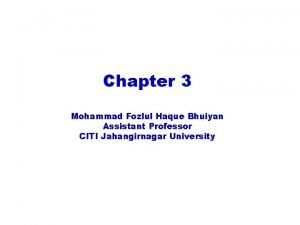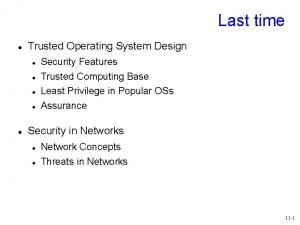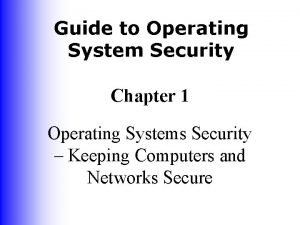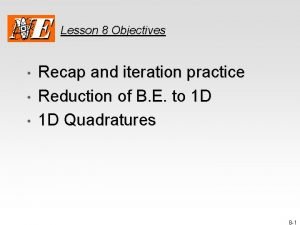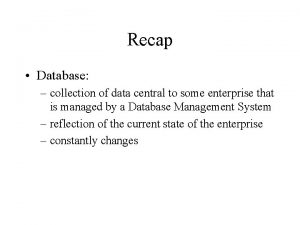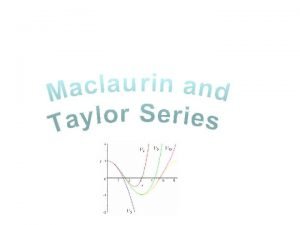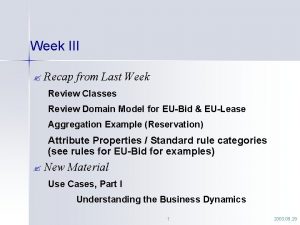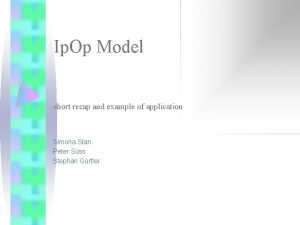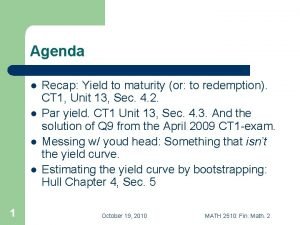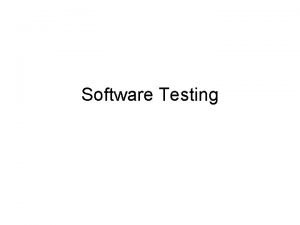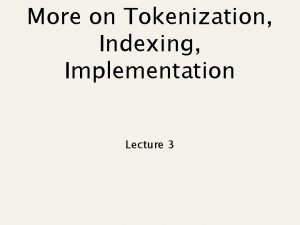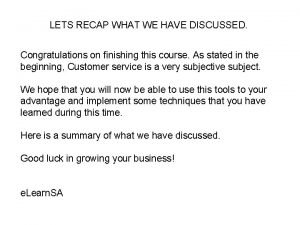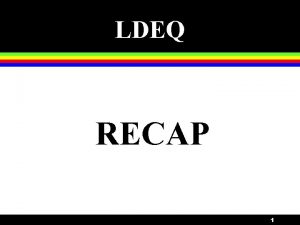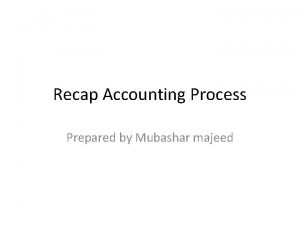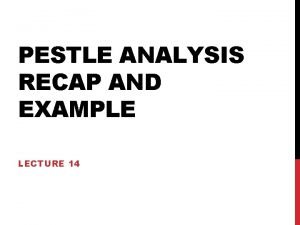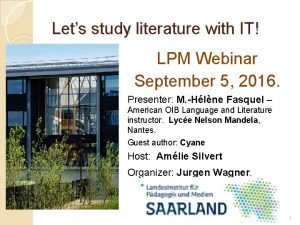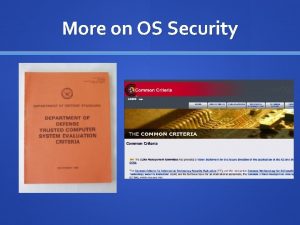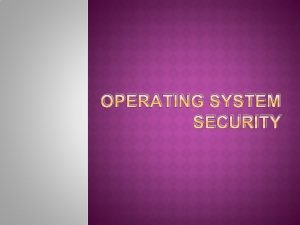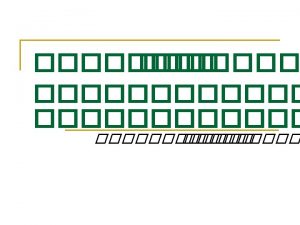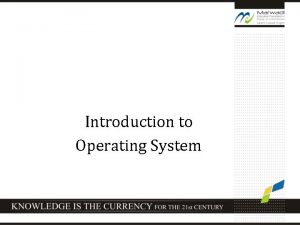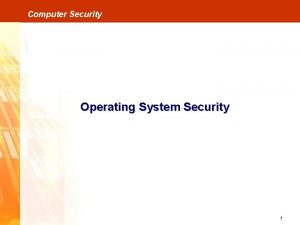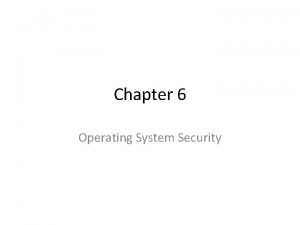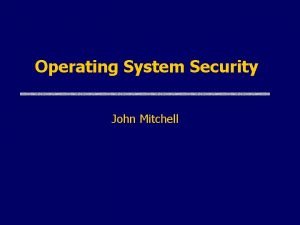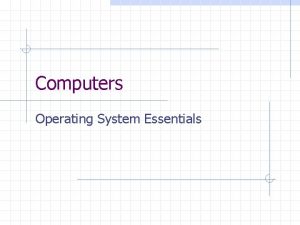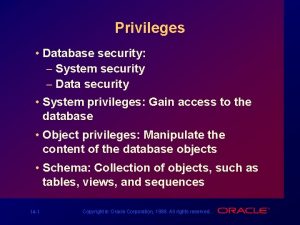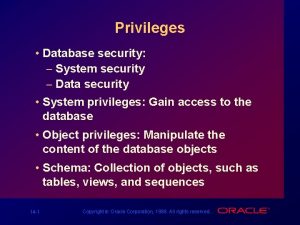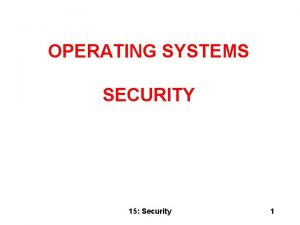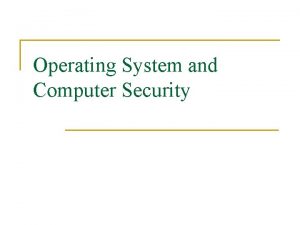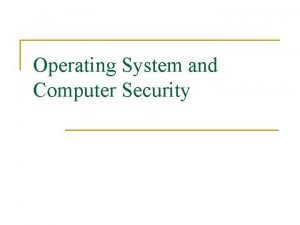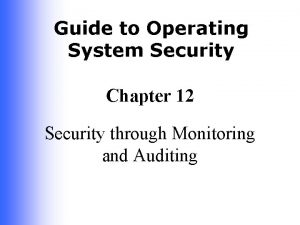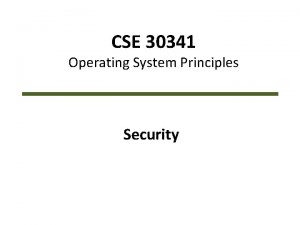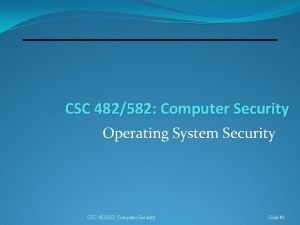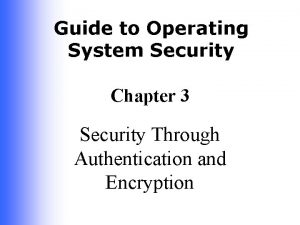More on OS Security Operating System Recap each











































- Slides: 43

More on OS Security

Operating System: Recap § each layer of code needs measures in place to provide appropriate security services § each layer is vulnerable to attack from below if the lower layers are not secured appropriately Security Layers

Measures The 2010 Australian Defense Signals Directorate (DSD) lists the “Top 35 Mitigation Strategies” Over 70% of the targeted cyber intrusions investigated by DSD in 2009 could have been prevented by fixing just four things. The top four measures for prevention are: patch operating systems and applications using auto-update patch third-party applications restrict admin privileges to users who need them white-list approved applications

Operating System Security possible for a system to be compromised during the installation process before it can install the latest patches building and deploying a system should be a planned process designed to counter this threat process must: assess risks and plan the system deployment secure the underlying operating system and then the key applications ensure any critical content is secured ensure appropriate network protection mechanisms are used ensure appropriate processes are used to maintain security

Process – regardless of OS! the purpose of the system, the type of information stored, the applications and services provided, and their security requirements who will administer the system, and how they will manage the system (via local or remote access) the categories of users of the system, the privileges they have, and the types of information they can access what access the system has to information stored on other hosts, such as file or database servers, and how this is managed how the users are authenticated how access to the information stored on the system is managed any additional security measures required on the system, including the use of host firewalls, anti-virus or other malware protection mechanisms, and logging

“Normal” OS features User authentication Memory protection File and I/O access control General object access control Enforcement of sharing and fairness guarantees Etc.

Trusted OS extra features MAC (in addition to DAC) Object re-use protection An attacker should not be able to gather information from resusable objects (such as disk memory) Complete mediation All objects access requests are checked each time (no caching) Audit capabilities Intruder detection capabilities

How to achieve? Standard tools are: Kernelized design Layered design Separation and isolation mechanisms Virtualization

Secure OS Kernels The fundamental idea in a secure kernel is to specify a core set of OS functions. Small and carefully built Key idea: if the kernel is safe, things built on top of it will be better off.

Kernelization pros and cons Advantages: Smaller amount of trusted code Easier to check every access Separates this piece from more complex portions of the system Easier to maintain and modify security features Disadvantages: Introduces boundaries Temptation is to move as much as possible in (especially since inside tends to be faster and cheaper to work with)

Major challenge in kernalization Need to decide which functions are in or out. What must be trusted in order to ensure security for the rest of the system? Answer: depends on definition of “secure” Certain types of attacks are still possible against “secure” systems Those attacks were just left off of the definition

Layered OS design This concept essentially generalized that of kernelization. Define an inner layer with high security. Each next layer builds on that, with lower security options. Outer layers use the inner ones through a strong interface. Example: Multics Pre-UNIX (and arguably more sophisticated and powerful) Key element was layered security model Still considered one of the most sophisticated secure OS deisgns

Separation and Isolation Divide the system into components Define a secure interface for each, and allow communication ONLY over interfaces Goal: Ensure nothing “bad” crosses the boundaries The OS can separate based on either user or process boundaries, not just functionality Overall, extremely successful OS security approach.

Separation and Isolation: Examples This is the core idea behind virtual memory processes and how they are set up to run securely. Key elements of several more secure OS designs, such as domain and type enforcement in SELinux. Domain and Type Enforcement (DTE) allows the system to specify security domains for processes and security types for objects. Restrict types available to specific domains, and only allow access in specified ways Very successful in SELinux.

DTE Example: FTP daemon and buffer overflows Create FTP domain, and only FTP daemon and files in FTP directory can be executed in this domain. These executables may not be written within this domain. So what happens for a buffer overflow? The buffer overflow might allow the attacker to try to execute a program (say, /bin/sh). But the FTP daemon program was in the FTP domain /bin/sh is of a type not executable from this domain And so the buffer overflow can’t fork a shell successfully

Example of DTE in SELinux Files in /etc are mostly limited ot access by a few sysadmin process types But /etc also contains /etc/aliases, which the mail program must access (And everyone uses the mail program!) So rules are set up to allow the sendmail process’ type to access /etc/aliases Sendmail process: type sendmail_t The /etc/aliases file gets type etc_aliases_t

SELinux sendmail rule The following rules allows processes of sentmail_t type to access files of etc_aliases_t type for read and write – without regard for which user started the process: allow sendmail_t etc_aliases_t: file { read write }; Permissions must be sufficient to allow normal work (read/write) but not too much to allow anyone to read and write everything in there.

Unix solution In contrast, in most linux distributions, sendmail is just set with setuid to a special user named “mail” (or something similar). Then /etc/aliases can be owned by mail user. Same result: any user can run the sendmail program, and sendmail can then access necessary data. So why is the SELinux approach better?

Unix versus SELinux approach Well, no need for fake users Central location for security-critical access control rules So no worries that a file somewhere may have incorrect permissions set. The sendmail process can now run under the identity of caller. In general, just a cleaner and nicer abstraction, although need to set up rules correctly.

Virtualization A technology that provides an abstraction of the resources used by some software which runs in a simulated environment called a virtual machine (VM) Simply run all untrusted things in a virtual machine, which can’t access critical security elements. There are some security pros and cons here, though. (More in a few slides. ) Can be used to run different OS applications, as well as tools such as Java.

Virtualization Alternatives application virtualization full virtualization allows applications written for one environment to execute on some other operating system multiple full operating system instances execute in parallel virtual machine monitor (VMM) hypervisor coordinates access between each of the guests and the actual physical hardware resources

Native Virtualization Security Layers

Hosted Virtualization Security Layers

Virtualization Issues Guest OS isolation Must ensure that programs executing within a guest OS may only access and use the resources allocated to it. Often, there are ways for the code to get out. Proper allocation of processes and resources. Put all related things in same VM? If not, must share data between them. Efficiency can be an issue.

Securing Virtualization Systems • carefully plan the security of the virtualized system organizations using virtualization should: • secure all elements of a full virtualization solution and maintain their security • ensure that the hypervisor is properly secured • restrict and protect administrator access to the virtualization solution

Hypervisor Security should be secured using a process similar to securing an operating system installed in an isolated environment configured so that it is updated automatically monitored for any signs of compromise accessed only by authorized administration may support both local and remote administration so must be configured appropriately remote administration access should be considered and secured in the design of any network firewall and IDS capability in use ideally administration traffic should use a separate network with very limited access provided from outside the organization

Assurance and testing Testing: run a bunch of tests to see if it is secure. But what tests? When are we sure? Not really a strong proof of security, although it is the most used. Formal verification: define goals formally and mathematically Use formal methods to “prove” that system meetings goals. Often difficult to map real system to formal statements, and difficult to prove anything for real systems.

Validation Define desired security in terms of: Features provided Architectural design Processes used in creation of system Evaluation methodology Then use a standardized procedure to demonstrate that your system fits the profile of a level of security. Usually done against a pre-defined standard, which you can then label your system as.

Validation: pros and cons The good: Allows easy comparisons of systems. Easy to have security “grades” for systems. Relatively open and fair process. The bad: Doesn’t actually really prove anything – only as good as the standards set by the system. Can be expensive.

Secure OS standards We actually briefly discussed the standard OS classifications briefly when talking about MAC. Common ones: U. S. Orange Book European ITSEC U. S. Combined Federal Criteria Common Criteria for IT Security Evaluation

The Orange Book First evaluation standard – developed by Do. D in late 70’s. Now largely historical artifact, although terminology is still around. Levels A, B, C, and D, in decreasing order of security, with important subdivisions in each (1, 2, 3…) Required formal certification from government for anything above the D level.

Orange Book classes C 2 example: Windows NT DAC at fairly low granularity Access auditing Password authentication and protection of reused objects B 1 example: Pit. Bull variant of Solaris Includes MAC using Bell-La Padula model This is the highest classification that a standard OS with extra security added can get – much harder to go higher.

Orange Book classes (cont) The B 3 class (example: Trusted Mach) Requires more careful security design as well as some level of verification No formal verification, but needs a “convincing argument” Extensive testing required In general, the OS is designed with security in mind from the beginning. (In general, less user friendly and much more expensive. )

Failure of the Orange Book Expensive Didn’t meet industry needs – was focused more on military requirements, and so was fairly inflexible. Certified products were not marketed quickly. Wasn’t clear that certification meant much. Windows NT was definitely not secure. Review was tied to the government.

The Common Criteria Current international standard (for many aspects of computer security, not just OS) Basics (with many TLAs): Evaluation Assurance Levels (EAL) Common Evaluation Methodology (CEM) Essentially gives a very detailed methodology for specifying: Security goals Operating environment Desired mechanisms Measures of success

The CC in practice You need a secure system, and so specify requirements using the CC methodology. Then you can look for products that meet these requirements or else develop one that does. Generally, independent labs then verify that the product meets the desired profile. In practice, a few are commonly used, and you generally select one that meets your needs from the list.

CC status Wide usage in many countries Including agreements in many places to honor other countries’ certifications Many products already certified Remaining issues: Still expensive and slow Unclear how meaningful certifications are Example: Windows 2000 was certified EAL 4+ (in a range of 17), but needed a ton of patches and was not regarded as “secure”.

TPM and Trusted Computing Goal: incorporate specialized hardware to improve security. Built into personal computers, but these components are tamperproof and special purpose. Three basic functionalities: Secure storage and use of keys Secure software attestations Secured data

TPM Key Storage All crypto keys are stored in a tamperproof area TPM hardware generates RSA keys pairs using “true” random number generators. Each TPM chip has a permanent key, and others are generated as needed. The permanent key can be used to sign and prove where things come from. Actually a private/public key pair, and the private part never leaves the dedicated hardware.

TMP and Crypto Hardware includes encryption and decryption functions, so that keys never leave the hardware. Data comes in and is encrypted or decrypted locally. Users have only limited interaction with crypto components in order to minimize issues.

TPM Attestations Essentially provides proof that a particular piece of software is funning on the machine. Really a signature on a hash of the software. Why? Can guarantee certain level of software or OS is running. One way to enforce security standards on both sides of a communication, or to require certain levels and standards. Example: boot loader can require a check that the OS is the one it intends to load, and quit if not. Prevents attacker from loading a corrupted kernel.

TPM and Data Security Can encrypt data with keys on one machine. Data can then ONLY be decrypted on that machine. Can even be sealed so that one a particular application can access it. This technology is the basis for many secure encryption devices. (Very popular on TV these days. )

TPM controversies “Who’s computer is this, anyway? ” Many critics worry about DRM issues Companies are using it to block competition in some settings Practicality issues: patching, releases, etc.
 Lirik lagu more more more we praise you
Lirik lagu more more more we praise you More more more i want more more more more we praise you
More more more i want more more more more we praise you Privat security
Privat security Recap coordinate system
Recap coordinate system Security and protection in operating system
Security and protection in operating system Security and protection in operating system
Security and protection in operating system Security and protection in operating system
Security and protection in operating system Operating system security trent jaeger
Operating system security trent jaeger Protection and security in operating system
Protection and security in operating system Linux security features
Linux security features Mandatory protection system
Mandatory protection system Operating system security
Operating system security Operating system security
Operating system security Operating system security problems
Operating system security problems Operating system security features
Operating system security features Operating system security features
Operating system security features The shawshank redemption short summary
The shawshank redemption short summary Chapter 8 of great gatsby summary
Chapter 8 of great gatsby summary Segmented pricing
Segmented pricing What is the purpose of an iteration recap?
What is the purpose of an iteration recap? Recap intensity clipping
Recap intensity clipping 60 minutes recap
60 minutes recap Recap database
Recap database Bracket power rule
Bracket power rule Introduction for recap
Introduction for recap Recap introduction
Recap introduction Recap from last week
Recap from last week Discussion questions for act 1 of the crucible
Discussion questions for act 1 of the crucible Ezekiel cheever motivation
Ezekiel cheever motivation Logbook recap example
Logbook recap example Ytm recap
Ytm recap Black box recap
Black box recap Fractions recap
Fractions recap Recap
Recap Recap indexing scans
Recap indexing scans Let's have a quick recap
Let's have a quick recap Recap poster
Recap poster Public transportation essay
Public transportation essay Ldeq recap
Ldeq recap Romeo and juliet act 1 summary
Romeo and juliet act 1 summary Recap accounting
Recap accounting What is economic environment example
What is economic environment example Let's recap
Let's recap Perfect lesson 7
Perfect lesson 7




